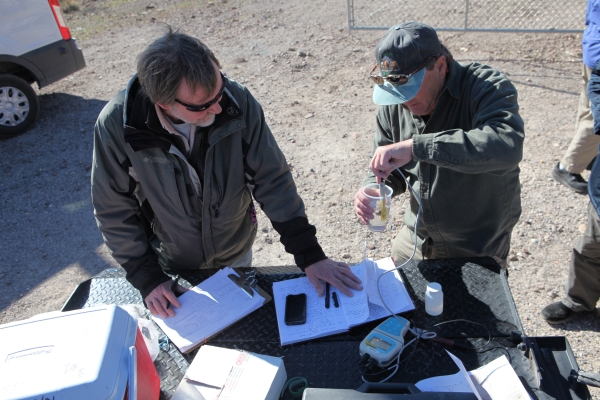
The final stage of groundwater sampling to determine the amount of tritium in Nye County wells around Nevada National Security Site took place Wednesday.
As part of the procedure that was supported by the Department of Energy grant award, Nye County officials collected water samples from 10 wells in Amargosa Valley and Beatty, the two downgradient locations from areas formerly used for nuclear weapons testing.
The cost of the endeavor, which was preceded by a score of preparations, came to $50,000. After Nye County accepted a five-year $1,277,000 grant award from the DOE for a Tritium Groundwater Monitoring Program in August, officials said it will be disbursed in increments of $252,000 on a yearly basis.
“So, when you are looking for evidence of transport of contaminants, tritium will be the first one to show up and you will see it first,” said Jamie Walker, Nye County contract geologist. “It’s relatively simple to analyze for, it’s not complicated and it’s referred to as the ultimate tracer.”
A soluble contaminant that moves with the groundwater at the rate of the groundwater flow, tritium has a 12.2-year lifespan. Its maximum contamination level for drinking water set by the EPA is 20,000 picocuries per liter, officials said.
Nye County officials said they will supply the collected information to the Community Environmental Monitoring Program (CEMP) that previously looked at atmospheric counters and groundwater around the Nevada National Security Site but has been shifting its focus to downgradient portions of the water.
A day-long tour attracted a group of local officials and community stakeholders who observed Klenke and Walker take samples of water from wells and measuring their parameters. Nye County Planning Director Darrell Lacy was also on hand answering questions and talking history of Nevada National Security Site.
“Nye County has always looked at this that if there if there was ever going to be any contamination or risk to the public, it would through the water table. That’s why we have focused our own science program on looking at the water,” Lacy said.
For the next four years, Nye County officials said they will sample 20 wells in offsite locations per year for tritium.
In a memo presented to the public, Nye County officials said they would like to continue working with CEMP through various opportunities to identify locations of interest for sampling.
Nye County geoscientist John Klenke, who took tritium samples along with Walker, said he doesn’t expect to find any traces of the contaminant in the groundwater.
“We don’t expect to see anything; stuff is not going to move off the test site for a long, long time. But just to be absolutely sure, DOE wants to be proactive and make sure that these things are getting looked at,” Klenke said.
The larger part of the $1.3 million grant is for Nye County to be involved in the Underground Test Area (UGTA) pre-emptive review meetings. UGTA is the DOE program responsible for characterizing the groundwater contamination on the NNSS by drilling wells, taking groundwater samples, building computer models and process validation.
Officials will send the collected samples for testing to the Radiation, Safety, Engineering, Inc. laboratory in Chandler, Arizona.
Contact reporter Daria Sokolova at dsokolova@pvtimes.com. On Twitter: @dariasokolova77